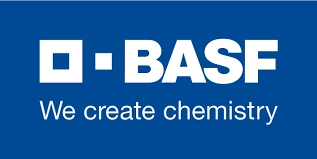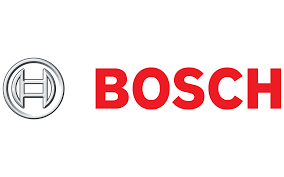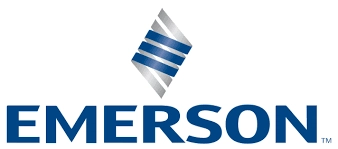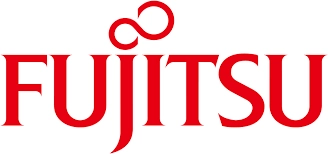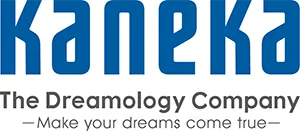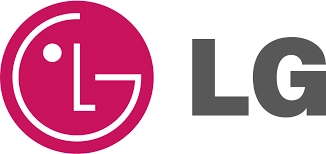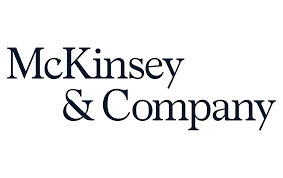Baby Food Market Overview 2024:
The baby food market size was USD 100 billion in 2023 and is expected to register a rapid revenue CAGR of 6.5% during the forecast period. Key factors such as changing lifestyles and demographics, rising awareness about proper nutrition for toddlers and infants, and increasing health concerns and allergies are expected to drive global market growth during the forecast period.
Baby food also called infant food is a specialty nutrition food with a highly-balanced composition aimed at mimicking break milk. These food products are designed to meet the nutritional needs of babies as they transition from breastfeeding or formula feeding to solid foods.
Baby food comes in various forms such as purees, snacks, cereals, and ready-to-eat meals, and includes essential nutrients such as proteins, carbohydrates, vitamins, minerals, and fats. These nutrients are crucial for supporting physical and cognitive development during the early stages of life.
Baby food products undergo rigorous safety and quality checks to ensure they are free from harmful contaminants and pathogens and are easily available in both commercial as well as homemade varieties.
However, premium and organic baby food products come with higher price tags. This can limit its adoption in developing economies. In addition, there are negative perceptions of processed food related to additives, preservatives, and excessive sugar or salt content.
Graphical Overview:
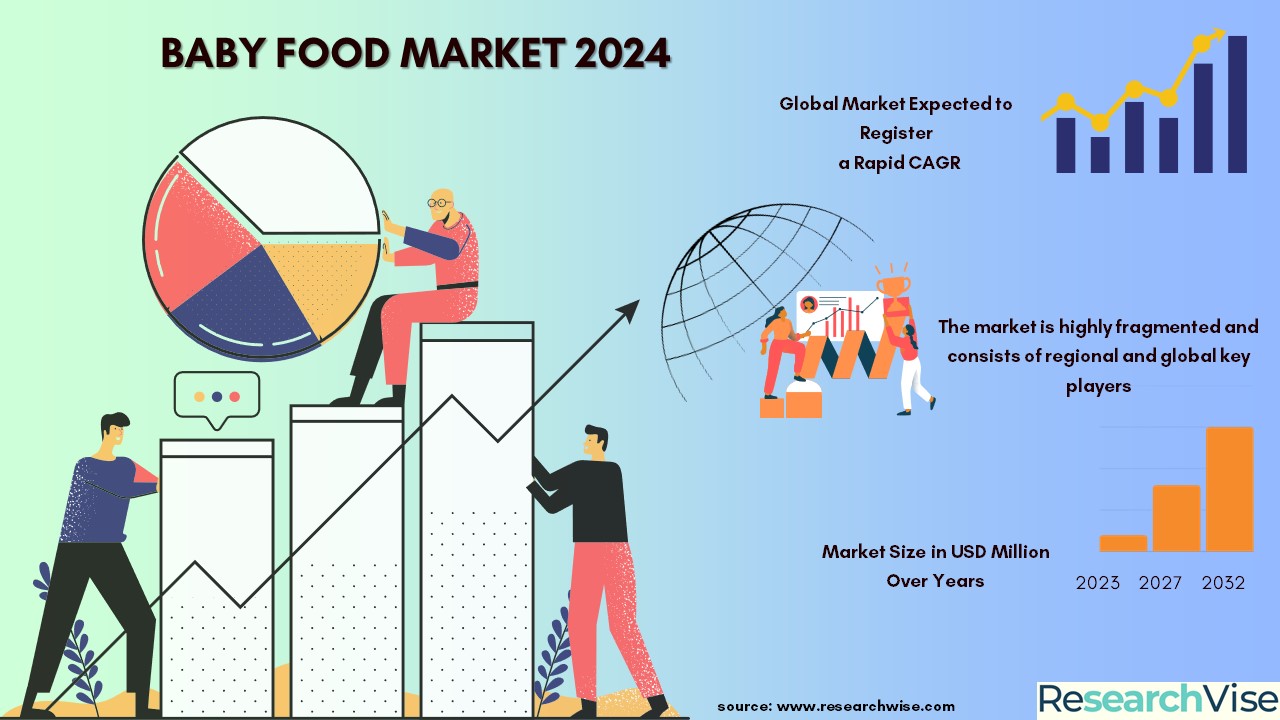
Key Takeaways:
Hectic Lifestyles and Going Demand for Portable and Easy-to-use Baby Food Products:
Busy lifestyles and dual-income settings often lead to constraints for parents to provide home-cooked food. This has resulted in increasing demand for convenient, portable, and easy-to-use baby food products. Moreover, rising disposable income, increasing dual-income households, and rising investments in R&D activities are other factors that can drive global market growth during the forecast period.
Competition from Homemade Options and Regulatory Challenges:
Many parents prefer homemade baby food as it is fresher, healthier, and cost-effective compared to packaged food alternatives. This can hamper overall market growth to a certain extent during the forecast period. In addition, stringent regulatory challenges related to safety and labeling is expected to restrain market growth going ahead.
Product Outlook:
Based on product, the global baby food market is segmented into milk formula, dried, ready-to-feed, and others. The milk formula segment is expected to account for a significantly larger revenue share during the forecast period owing to high demand for infant formula as an alternative to breast milk due to its nutritional contents and easy availability of milk formula in powder, liquid concentrate, and ready-to-feed options.
Application Outlook:
The global market is segmented into drugstores, supermarkets, convenience stores, health and beauty retailers, online channels, and others. The drugstores segment is expected to register a rapid revenue CAGR over the forecast period owing to rising availability of various types of baby food products in drugstores to cater to growing demand and presence of larger section of baby products in drugstores as compared to convenience stores or health and beauty retailers.
Regional Outlook:
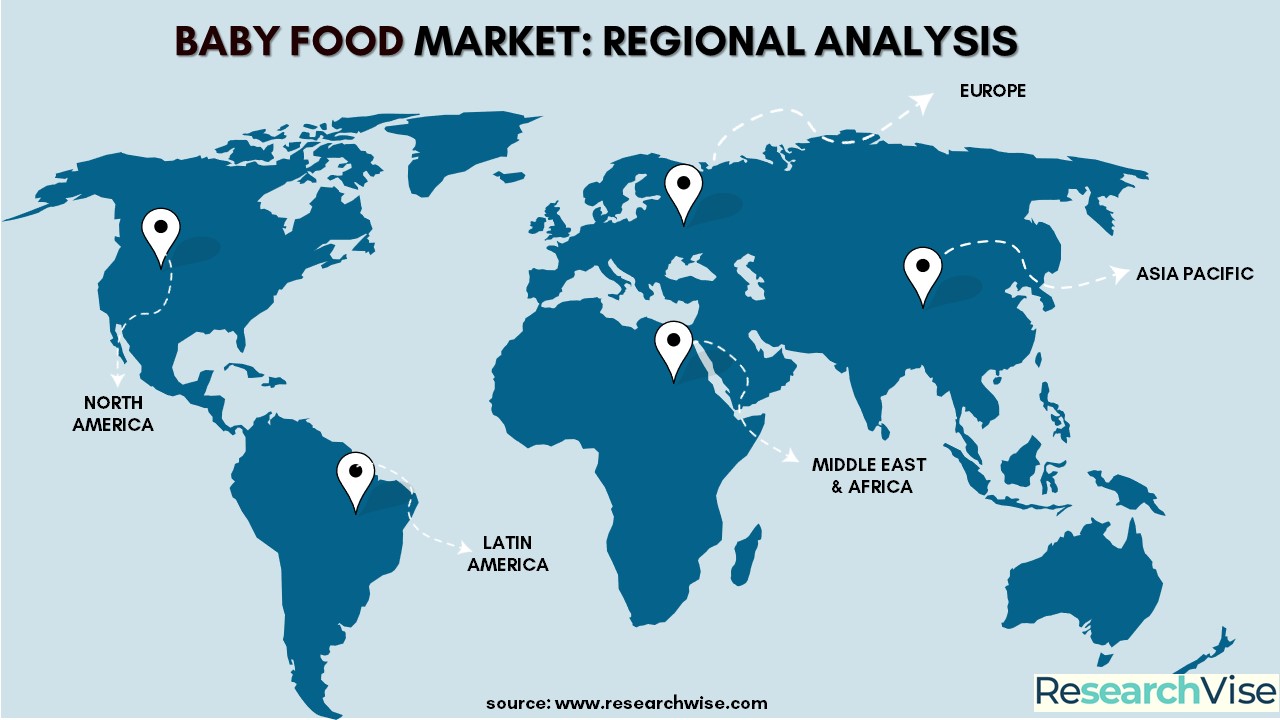
North America is expected to account for the largest revenue share during the forecast period owing to increasing awareness about proper nutrition for infants and toddlers, rising availability of various types of baby food products, and high disposable income. Moreover, changing lifestyles and demographics, presence of leading companies, and rising investments in developing baby food in novel formulations and flavors are other factors expected to drive North America market growth during the forecast period.
Report Coverage:
| Report Details |
Outcome |
| Base Year for Estimation |
2023 |
| Historical Data |
2018-2022 |
| Forecast Period |
2024-2032 |
| Segments Covered: |
Product, Formulation, Age Group, Distribution Channel, and Region |
| By Product |
Milk Formula, Dried, Ready-to-Feed, Others |
| By Formulation |
Powder, Liquid |
| By Age Group |
Infants, Babies, Toddlers |
| By Distribution Channel |
Drugstores, Supermarkets, Convenience Stores, Health and Beauty Retailers, Online Channels, Others |
| Regional Scope |
North America, Europe, Asia Pacific, Latin America, Middle East and Africa |
| Country Scope |
United States, Canada, Germany, France, UK, Italy, Russia, China, Japan, South Korea, Southeast Asia, India, Mexico, Brazil, Saudi Arabia, UAE, Turkey |
| Qualitative Info |
•Value Chain Analysis
•Pricing Analysis
•Regional Outlook
•Market Trends
•Market Share Analysis
•Competition Analysis
•Technological Advancements |
| Key Players |
Bellamys Organic Pty Ltd, Abbott Laboratories, Royal FrieslandCampina N.V., Hero AG, Nestle S.A, Sun-Maid Growers of California, Danone S.A., Mead Johnson & Company, LLC., Perrigo Company PLC, The Hain Celestial Group, Inc. |
| Customization Scope |
10 Hours of Free Customization and Expert Consultation |
Competitive Landscape:
The global Baby Food market is extremely competitive, comprising several regional and global level key players. Leading key players are focused on adopting various strategic alliances like mergers and acquisitions, partnerships, joint ventures, collaborations, and product launches to maintain their global position and enhance their product offerings. They are also focused on innovation, and scalability, and are adapting to evolving technology trends and consumer needs.
Some Leading Market Companies Listed in the Report:
- Bellamys Organic Pty Ltd
- Abbott Laboratories
- Royal FrieslandCampina N.V.
- Hero AG
- Nestle S.A
- Sun-Maid Growers of California
- Danone S.A.
- Mead Johnson & Company, LLC.
- Perrigo Company PLC
- The Hain Celestial Group, Inc.
Baby Food Industry Recent Developments:
- In August 2023, Beech-Nut Nutrition Co., a manufacturer of food products for toddlers and babies announced the launch of Brownies with Hidden Veggies formulated from butternut squash, carrots, and raisins, available in flavors like Hootin’ Peanut Butter and Paw-sitively Cocoa.
- In July 2022, Danone announced the launch of Dairy and Plants Blend, a plant-based baby formula to cater to rising demand for vegetarian, vegan, and flexitarian diets.
- In April 2022, Nestlé-owned brand Gerber announced the launch of carbon-neutral, plant-based baby food, called Plant-tastic.
The global baby food market has been segmented based on product, formulation, age group, distribution, and region:
By Product:
- Milk Formula
- Dried
- Ready-to-Feed
- Others
By Formulation:
By Age Group:
By Distribution Channel:
- Drugstores
- Supermarkets
- Convenience Stores
- Health and Beauty Retailers
- Online Channels
- Others
By Region:
- North America
- Europe
- Germany
- France
- UK
- Italy
- Russia
- Nordic Countries
- Asia Pacific
- China
- Japan
- South Korea
- Southeast Asia
- India
- Australia
- Rest of Asia
- Latin America
- Mexico
- Brazil
- Rest of Latin America
- Middle East & Africa
- Turkey
- Saudi Arabia
- UAE
- Rest of MEA
Frequently Asked Questions!
The Baby Food Market is segmented based on Type, Application, and by region.
- Bellamys Organic Pty Ltd
- Abbott Laboratories
- Royal FrieslandCampina N.V.
- Hero AG
- Nestle S.A
- Sun-Maid Growers of California
- Danone S.A.
- Mead Johnson & Company, LLC.
- Perrigo Company PLC
- The Hain Celestial Group, Inc.
are the top players in the market.
The Baby Food Market report provides global companies with an opportunity to enter new markets, invest in new sectors, analyze consumer reactions, investigate global competition, and ultimately make smart investments.
Factors such as competitive strength and market positioning are key areas considered while selecting top companies to be profiled.
Chapter 1. Methodology and Scope
1.1. Methodology Segmentation & Scope
1.2. Information Procurement
1.2.1. Purchased database
1.2.2. Secondary Sources
1.2.3. Third-party Perspectives
1.2.4. Primary research
1.3. Information Analysis
1.3.1. Data Analysis Models
1.4. Market Formulation & Data Visualization
1.5. Research Scope & Assumptions
Chapter 2. Executive Summary
2.1. Baby Food Market- Industry Snapshot, 2018 - 2032
Chapter 3. Baby Food Market Variables, Trends & Scope
3.1. Market Size and Growth Prospects, 2024-2032
3.2. Industry Value Chain Analysis
3.3. Market Dynamics
3.3.1. Market Driver Analysis
3.3.2. Market Restraint/Challenge Analysis
3.3.3. Market Opportunity Analysis
3.4. Penetration & Growth Prospect Mapping
3.5. Business Environment Analysis Tools
3.5.1. Industry Analysis - Porter's Five Forces Analysis
3.5.2. PEST Analysis
3.5.3. COVID-19 Impact Analysis
Chapter 4. Baby Food Market Type Outlook 2024-2032 (USD Million)
Chapter 5. Baby Food Market Application Outlook 2024-2032(USD Million)
Chapter 6: Coronavirus Diseases (COVID-19) Impact:
6.1. Introduction
6.2 Current and Future Impact Analysis
6.3 Economic Impact Analysis
6.4 Investment Scenario
Chapter 7. North America Baby Food Market Share by Region, 2024 & 2032 (USD Million)
7.1. Market Estimates and Forecast 2024 - 2032 (USD Million)
7.2. Market Estimates and Forecast by Type, 2024-2032 (USD Million)
7.3. Market Estimates and Forecast by Application, 2024-2032 (USD Million)
7.4.1. U.S.
7.4.1.1. Market Estimates and Forecast 2024-2032 (USD Million)
7.4.1.2. Market Estimates and Forecast by Type, 2024-2032 (USD Million)
7.4.1.3 Market Estimates and Forecast by Application, 2024-2032 (USD Million)
7. 4.2. Canada
7. 4.2.1. Market Estimates and Forecast 2024-2032 (USD Million)
7. 4.2.2. Market Estimates and Forecast by Type, 2024-2032 (USD Million)
7. 4.2.3 Market Estimates and Forecast by Application, 2024-2032 (USD Million)
Chapter 8. Europe Baby Food Market Share by Region, 2024 & 2032 (USD Million)
8.1. Market Estimates and Forecast 2024 - 2032 (USD Million)
8.2. Market Estimates and Forecast by Type, 2024-2032 (USD Million)
8.3. Market Estimates and Forecast by Application, 2024-2032 (USD Million)
8.4.1. Germany
8.4.1.1. Market Estimates and Forecast 2024-2032 (USD Million)
8.4.1.2. Market Estimates and Forecast by Type, 2024-2032 (USD Million)
8.4.1.3. Market Estimates and Forecast by Application, 2024-2032 (USD Million)
8.4.2. France
8.4.2.1. Market Estimates and Forecast 2024-2032 (USD Million)
8.4.2.3. Market Estimates and Forecast by Type, 2024-2032 (USD Million)
8.4.2.3. Market Estimates and Forecast by Application 2024-2032 (USD Million)
8.4.3. UK
8.4.3.1. Market Estimates and Forecast 2024-2032 (USD Million)
8.4.3.2. Market Estimates and Forecast by Type, 2024-2032 (USD Million)
8.2.3.3. Market Estimates and Forecast by Application 2024-2032 (USD Million)
8.4.4. Italy
8.4.4.1. Market Estimates and Forecast 2024-2032 (USD Million)
8.4.4.2. Market Estimates and Forecast by Type, 2024-2032 (USD Million)
8.4.4.3. Market Estimates and Forecast by Application 2024-2032 (USD Million)
8.4.5. Russia
8.4.5.1. Market Estimates and Forecast 2024-2032 (USD Million)
8.4.5.2. Market Estimates and Forecast by Type, 2024-2032 (USD Million)
8.4.5.3. Market Estimates and Forecast by Application 2024-2032 (USD Million)
8.4.6. Nordic Countries
8.4.6.1. Market Estimates and Forecast 2024-2032 (USD Million)
8.4.6.2. Market Estimates and Forecast by Type, 2024-2032 (USD Million)
8.4.6.3. Market Estimates and Forecast by Application 2024-2032 (USD Million)
8.4.7. Rest of Europe
8.4.7.1. Market Estimates and Forecast 2024-2032 (USD Million)
8.4.7.2. Market Estimates and Forecast by Type, 2024-2032 (USD Million)
8.4.7.3. Market Estimates and Forecast by Application, 2024-2032 (USD Million)
Chapter 9. Asia Pacific Baby Food Market Share by Region, 2024 & 2032 (USD Million)
9.1. Market Estimates and Forecast 2024 - 2032 (USD Million)
9.2. Market Estimates and Forecast by Type, 2024-2032 (USD Million)
9.3. Market Estimates and Forecast by Application, 2024-2032 (USD Million)
9.4.1. China
9.4.1.1. Market Estimates and Forecast 2024-2032 (USD Million)
9.4.1.2. Market Estimates and Forecast by Type, 2024-2032 (USD Million)
9.4.1.3. Market Estimates and Forecast by Application, 2024-2032 (USD Million)
9.4.2. Japan
9.4.2.1. Market Estimates and Forecast 2024-2032 (USD Million)
9.4.2.2. Market Estimates and Forecast by Type, 2024-2032 (USD Million)
9.4.2.3. Market Estimates and Forecast by Application, 2024-2032 (USD Million)
9.4.3. South Korea
9.4.3.1. Market Estimates and Forecast 2024-2032 (USD Million)
9.4.3.2. Market Estimates and Forecast by Type, 2024-2032 (USD Million)
9.4.3.3. Market Estimates and Forecast by Application, 2024-2032 (USD Million)
9.4.4. India
9.4.4.1. Market Estimates and Forecast 2024-2032 (USD Million)
9.4.4.2. Market Estimates and Forecast by Type, 2024-2032 (USD Million)
9.4.4.3. Market Estimates and Forecast by Application, 2024-2032 (USD Million)
9.4.5. Australia
9.4.5.1. Market Estimates and Forecast 2024-2032 (USD Million)
9.4.5.2. Market Estimates and Forecast by Type, 2024-2032 (USD Million)
9.4.5.3. Market Estimates and Forecast by Application, 2024-2032 (USD Million)
9.4.6. Rest of Asia Pacific
9.4.6.1. Market Estimates and Forecast 2024-2032 (USD Million)
9.4.6.2. Market Estimates and Forecast by Type, 2024-2032 (USD Million)
9.4.6.3. Market Estimates and Forecast by Application, 2024-2032 (USD Million)
Chapter 10. Latin America Baby Food Market Share by Region, 2024 & 2032 (USD Million)
10.1. Market Estimates and Forecast 2024 - 2032 (USD Million)
10.2. Market Estimates and Forecast by Type, 2024-2032 (USD Million)
10.3. Market Estimates and Forecast by Application, 2024-2032 (USD Million)
10.4.1. Mexico
10.4.1.1. Market Estimates and Forecast 2024-2032 (USD Million)
10.4.1.2. Market Estimates and Forecast by Type, 2024-2032 (USD Million)
10.4.1.3. Market Estimates and Forecast by Application, 2024-2032 (USD Million)
10.4.2. Brazil
10.4.2.1. Market Estimates and Forecast 2024-2032 (USD Million)
10.4.2.2 Market Estimates and Forecast by Type, 2024-2032 (USD Million)
10.4.2.3. Market Estimates and Forecast by Application, 2024-2032 (USD Million)
10.4.3 Rest of Latin America
10.4.3.1 Market Estimates and Forecast 2024-2032 (USD Million)
10.4.3.2. Market Estimates and Forecast by Type, 2024-2032 (USD Million)
10.4.3.3. Market Estimates and Forecast by Application, 2024-2032 (USD Million)
Chapter 11. Middle East and Africa Baby Food Market Share by Region, 2024 & 2032 (USD Million)
11.1. Market Estimates and Forecast 2024 - 2032 (USD Million)
11.2. Market Estimates and Forecast by Type, 2024-2032 (USD Million)
11.3. Market Estimates and Forecast by Application, 2024-2032 (USD Million
11.4.1 Turkey
11.4.1.1 Market Estimates and Forecast 2024-2032 (USD Million)
11.4.4.2. Market Estimates and Forecast by Type, 2024-2032 (USD Million)
11.4.4.3. Market Estimates and Forecast by Application, 2024-2032 (USD Million)
11.4.2. Saudi Arabia
11.4.2.1. Market Estimates and Forecast 2024-2032 (USD Million)
11.4.2.2 Market Estimates and Forecast by Type, 2024-2032 (USD Million)
11.4.2.3. Market Estimates and Forecast by Application, 2024-2032 (USD Million)
11.4.3 UAE
11.4.3.1. Market Estimates and Forecast 2024-2032 (USD Million)
11.4.3.2. Market Estimates and Forecast by Type, 2024-2032 (USD Million)
11.4.4.1. Market Estimates and Forecast by Application, 2024-2032 (USD Million)
11.4.5. Rest of MEA
11.4.5.1. Market Estimates and Forecast 2024-2032 (USD Million)
11.4.5.2. Market Estimates and Forecast by Type, 2024-2032 (USD Million)
11.4.5.3. Market Estimates and Forecast by Application, 2024-2032 (USD Million)
Chapter 12 Baby Food Market Competitive Landscape
- Bellamys Organic Pty Ltd
- Abbott Laboratories
- Royal FrieslandCampina N.V.
- Hero AG
- Nestle S.A
- Sun-Maid Growers of California
- Danone S.A.
- Mead Johnson & Company, LLC.
- Perrigo Company PLC
- The Hain Celestial Group, Inc.
- Bellamys Organic Pty Ltd
- Abbott Laboratories
- Royal FrieslandCampina N.V.
- Hero AG
- Nestle S.A
- Sun-Maid Growers of California
- Danone S.A.
- Mead Johnson & Company, LLC.
- Perrigo Company PLC
- The Hain Celestial Group, Inc.


